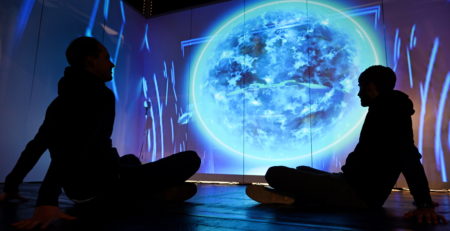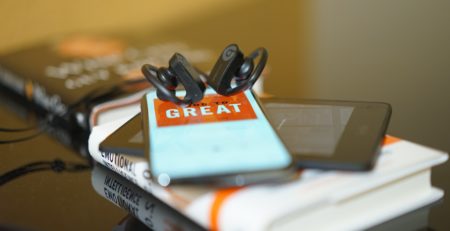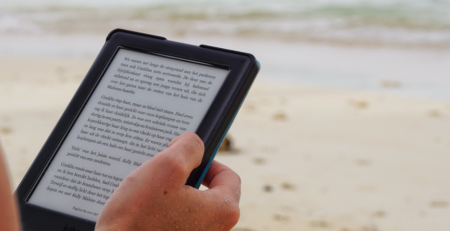Immersion or Disruption? Möbius Pilot 1 Results on Readers’ Evaluation of and Requirements for 3D-audio as a Tool to Support Immersion in Digital Reading Practices
In the first Pilot Phase, we aimed to gather in-depth insights into the personal experiences of avid readers, using online focus group discussions to gather in-depth insights into the current reading practices of avid readers. At the same time, we wanted to define the requirements for 3D audio to complement digital reading. We did this through 3 co-creation sessions with 18 readers between 24 and 54 years old. Group discussions were held online in Belgium (by VUB, conducted in English on 14 and 21 February 2022 – with 14 participants) and in Germany (by MVB, performed in German on 3 March 2022 – 4 participants).
Table 1: Participants in the Online Group Discussions
| Location | Number of participants | ||
| Female | Male | Total | |
| Belgium (1) | 7 | 1 | 8 |
| Belgium (2) | 3 | 3 | 6 |
| Germany | 4 | 4 | |
| Total | 14 | 4 | 18 |
To prepare for the discussion on 3D audio, we asked participants to read a chapter of The Influence of Blue and simultaneously test four 3D-audio tracks accompanying the chapter. The chapter and audio tracks were in English and available via the Thorium Reader application. Participants received a manual on how to install the application and how to use it and test the 3D-audio content via mail at least one week before the online meeting. They were asked to listen to each of the tracks. While (reading and) listening to the audio tracks, highlights indicated in the written text which parts the narrator was reading. The table below gives an overview of the audio tracks that were made available to the participants:
Table 2: List of 3D-Audio Tracks
| Track name | Track content |
| Track 1 | Narrator |
| Track 2 | Narrator and ambient sounds |
| Track 3 | Narrator and music |
| Track 4 | Narrator, ambient sounds and music |
Table 2 shows the topics addressed in the discussion and co-creation session. Several issues listed for the discussion were visualized via Miro, an online whiteboard.
Table 3: Visual Pointers for Participants in the Online Focus Group Discussion
| Topic | Visualisation |
| Introduction | Informed consent (in Qualtrics) via screen share |
| Getting acquainted and sharing practices | Pictures of everyday reading habits are presented in Miro. Participants could refer to images when submitting themselves and how they read. |
| Defining immersion | Visualisation of the points made during the discussion through note-taking in Miro (post-its) |
| Requirements for 3D-audio | Visualisation of the points made during the discussion through note-taking in Miro (post-its) |
| Closing | Adding final points via post-its in Miro where needed |
RESULTS: Evaluation AND USER REQUIREMENTS
In general, most participants took some getting used to the narrator and the music and ambient soundtracks. However, many participants indicated that music and ambient sounds have the potential to aid immersion. The type of track considered the most ‘immersive’ differed according to the participants’ personal preferences. As this participant mentioned:
“Individually, I found [the music and ambient audio tracks] a little distracting, but for some reason, when you put them together, it just kind of… it almost helps me like to focus more on this story, I guess. I know that doesn’t make much sense, like why they wouldn’t work independently, why they would all of a sudden make the story more immersive when put together. But I found the [ambient sounds] and music put together to be pretty memorable and immersive.” (MW, Male, FG 21.02.22).
Some participants mentioned the inclusion of music tracks in reading applications would save them time, as they currently combine reading with listening to music via streaming apps such as Spotify:
“You know, so for me, I think it was a nice experience, especially [Track 4], because it helped me. It didn’t take anything away from me but it helped and put me in the mood. Sometimes when (…) it’s hard for me to get in the mood of the book, I try to find a playlist on Spotify about the book with this kind of music that matches what’s in it. This is fun because it’s already in the book. You don’t have to look for playlist.” (EB, Female, 14.02.22).
Personal preferences and context of the reader (such as reading skills or using music to focus) played a vital role in the 3D-audio tracks were evaluated. To move beyond the personal preferences and individual reader contexts, we separated the comments into five categories, distinguishing between (1) general aspects that apply to all audio tracks, (2) specifics for narration, (3) specifics for ambient sounds, (4) specifics for music, and (5) specifics for combined audio tracks. Table 4 below shows the aspects that participants indicated to influence the level of immersion for each of these five categories. All aspects affect the participants’ perception and experience of the audio tracks.
Table 4: 3D-audio Aspects that Influence Immersion
| General | Narration | Ambient sounds | Music | Combined audio |
| ‘Fit’ with the story | The tempo of the narrator (speaking pace) | Adapt to the mood in the story | Adapt to the mood in the story | The synergy of the tracks |
| Consistency in audio quality | The dialect of the narrator | Accurately represent the environment of the story | Accurately describe the story and its’ characters | |
| Variation in audio content | Timbre of the voice of the narrator | Adapt to the environment of the story | Build towards a climax | |
| The volume of the audio | Accuracy of the alignment with highlighted text | Build towards a climax |
Respondents also indicated an interest in added meaning from the audio tracks. This means the audio would enhance the story further:
“And what I find important in such a combination, so that also reminds me a lot of film music, that the one is not just a background to the other, but that it complements each other so that I don’t just get information from the text, but through the sound, some information is brought to me that I couldn’t otherwise get, or also through the music a mood is created that I wouldn’t even have read out otherwise.” (CB, Female, FG 03.03.22).
We asked respondents how these aspects could be implemented in a digital reading app. This analysis resulted in an initial requirement set, as shown in Table 5. The table includes requirements for producing audio content (labelled as content requirements) and requirements for technology developers to consider when developing a user-friendly reading application (labelled user requirements).
Table 5: Requirements for 3D-audio to Support Immersion in Reading Applications
| User Requirements | Users should be able to choose from various audio tracks, including different narrators, ambient sounds, and music. |
| Users should have control over the volume of each of the audio tracks. | |
| Users should have control over the speed of narration. | |
| Content Requirements | Audio tracks should fit the story, including narration, music and ambient sounds. |
| All audio tracks should adapt to the mood in the story and adjust when the mood changes. | |
| All audio tracks should accurately represent the stories’ characters. | |
| Music and Ambient soundtracks should build towards a climax. | |
| Ambient sounds should accurately represent the story’s environment and adapt when the environment changes. | |
| Combining the narrator, music, and ambient sounds should be balanced as a listening experience. | |
| Each story should offer various audio tracks, including different narrators, ambient sounds and music. |
NEXT STEPS
Pilot phase 2 will allow us to refine these requirements further. The following stages of Möbius involve
(1) testing a prototype of the reading application with a larger sample of end-users and (Pilot phase 2)
(2) allowing users to try the application in their daily lives to understand more about how the combination between audio and reading is influenced by the context the reader is in (Pilot phase 3)
Author: IMEC, Möbius Partner












